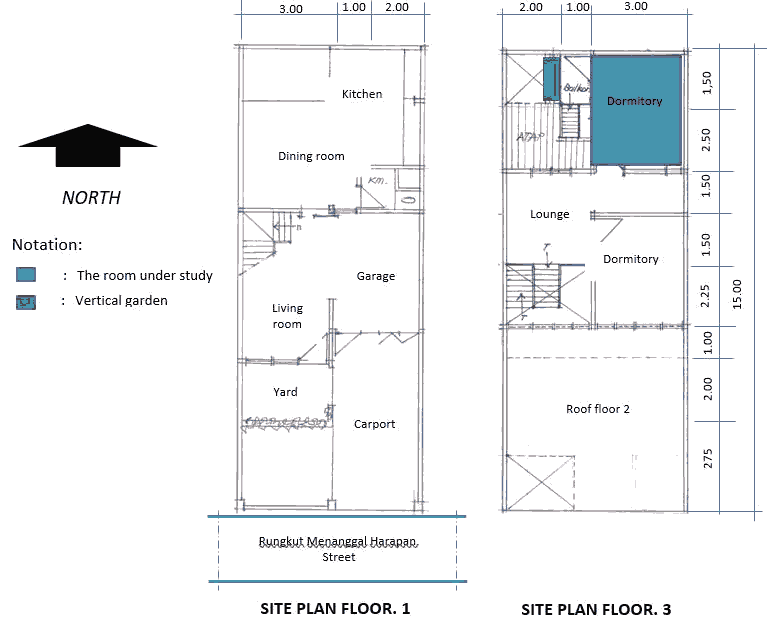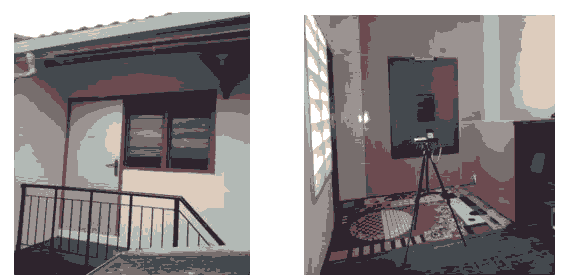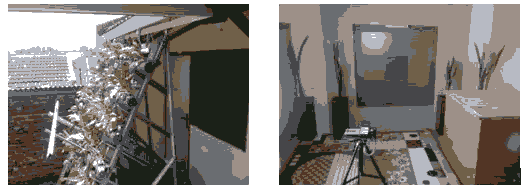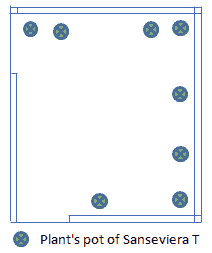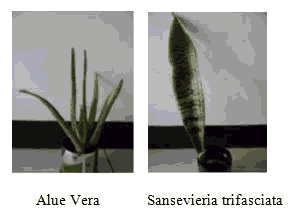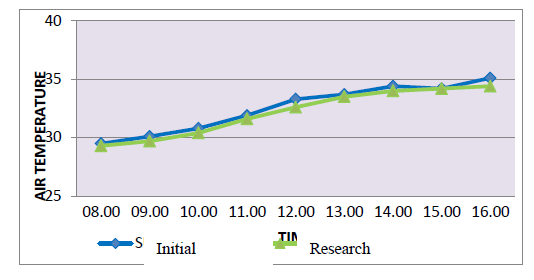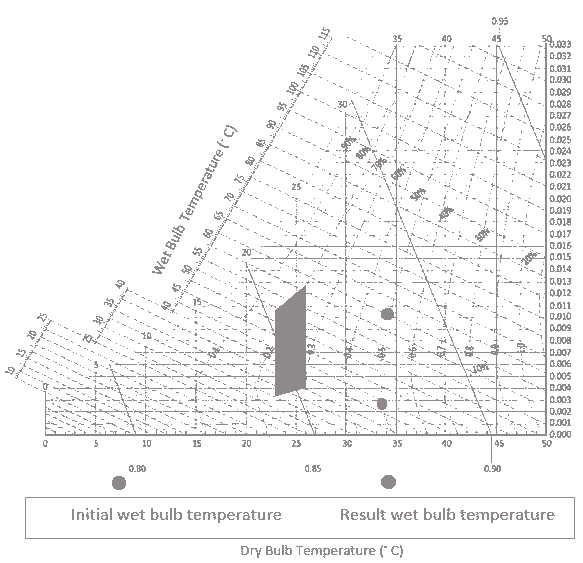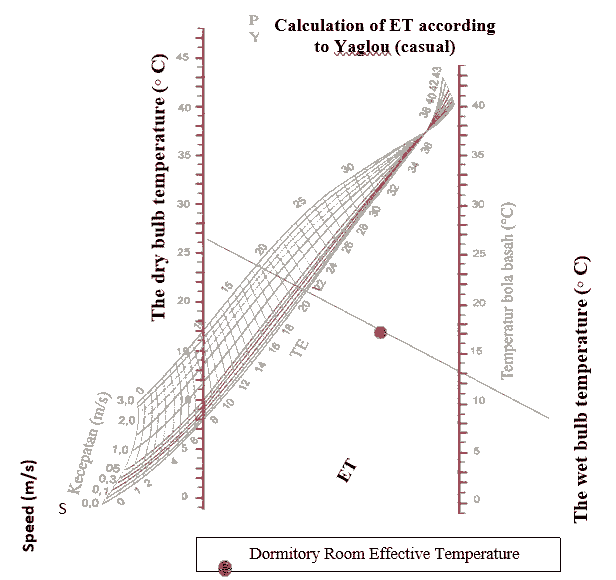Research Article: 2021 Vol: 20 Issue: 2S
Improving the Thermal Comfort of Room through a Combination of Outdoor and Indoor Parks: Evidence from Indonesia
Eddy Imam Santoso, Merdeka University
Keywords
Vertical Garden, Indoor Garden, Outdoor Garden, Thermal Comfort
Abstract
This study examines the thermal comfort of space in a student dormitory at the Rungkut Menanggal Harapan Residential Surabaya - Indonesia by providing an overview through the arrangement of a hydroponic vegetable garden vertically on the building (outdoor) facing the West (sun) and in combination with garden arrangement (Sansevieria trifacciata plant) indoors. Research objectively related to air temperature, relative humidity, wind speed and solar radiation in the conditions before being given a combination of indoor gardens and after being given an indoor garden, and subjectively involve interviews with users about the thermal comfort perceptions of the room. The results showed a decrease in air temperature of 0.4 º C and a decrease in CO2 levels of 0.12 ppm and an increase/release of O2 levels of 0.4%. This garden combination produces a neutral temperature of 26 ºC and a humidity of 40% which is still above the standard ASHRAE 55 comfort zone, but the perception of users with these thermal conditions can accept and feel higher thermal comfort
Introduction
Various studies on the thermal comfort of room have been carried out in an effort to determine whether the existing thermal environment is in accordance with the needs of comfortable living. Most of human life (more than ninety percent) is in room, so comfortable conditions are needed to support their activities (Chadee & Maharaj, 2020; Chen, Lai & Chen, 2020; Pang, Yang, Cao, Tian & Li, 2020; Pei, Dai, Li & Liu, 2020).
To get thermal comfort room, it can be done artificially or naturally. Artificially by means of a mechanical air conditioning system with air conditioning, and investigating the use of a fan, the air temperature ranges from 28.2 ºC and 27.2 ºC (Jalilzadehazhari, Vadiee & Johansson, 2019; Lam, Yuan & Wang, 2014; Lin & Li, 2017; Liu et al., 2020).
Natural air conditioning by regulating the air circulation system can be achieved through building designs. Increasing the comfort of room can also be done by providing a screen on the facade or certain parts of the building with plants/gardens arranged vertically so that it can provide a shadowing of the building and can reduce the room air temperature to 0.8 ºC, (Chow, Ren, Mathias & Liu, 2019; Cuce et al., 2019; Di, Zhilei & Pengkun, 2020).
The variables that affect thermal comfort are climatic variables which include air temperature, air velocity, relative humidity and radiation temperature, (Ajib, Lefteriu, Caucheteux & Lecoeuche, 2020; Coulby, Clear, Jones & Godfrey, 2020; Guan et al., 2020).
Based on research, providing sun protection using organic vegetable plants that are placed vertically in the building can reduce indoor air temperature by about 1.5 to 2 º C, but will increase air humidity which affects the thermal comfort of room, (Bidar et al., 2020; Cerbu, Wang, Botis, Huang & Plescan, 2020; Dumrongrojwatthana, Wanich & Trébuil, 2020). It is hoped that indoor garden arrangement with plants that absorb air humidity will increase the thermal comfort of the room.
Material and Methods
This research is a continuation of Santoso (2019) research which was conducted in the dry season from September 5 2018 to September 21 2018. The research was conducted in a dormitory room in Rungkut Menanggal Harapan, Rungkut Menanggal Village, Gununganyar District, Surabaya City, East Java Province, Indonesia. The dormitory room is part of a residence located on the third floor, with the North boundary of the neighboring building and the South boundary is the complex road of the East boundary attached to the neighboring building, the West boundary of the room or the open yard. Room dimensions, 3.00 m wide, 4.00 m long with an average ceiling height of 3.20 m. The dormitory room which is the object of research is a room with the openings facing the West and has a balcony. The east and north dormitories are bordered by massive walls, while the south and west walls consist of a plane with door and window openings. (Figure 1) The western opening that connects to the balcony is in the form of 2 (two) plain glass shutters that can be opened and closed and 1 (one) aluminum-coated plywood door, while the southern opening is 1 plain glass ventilation leaf that can be opened/closed and 1 plywood door that is not exposed to direct sunlight because it connects to the inner room (Figure 2). The multiplex floor material is carpeted and the ceiling is covered with GRC plate ceiling and concrete tile roof. Dormitory room is for 2 people with residential activities.
Garden Arrangement Patterns and Types of Plants
The outdoor garden is arranged vertically with a 60 degree slope using a loose system (placed on a shelf with hydroponic growing media placed on a 4 dim diameter pvc pipe) (Figure 3) so that all plants are directly exposed to the sun for photosynthesis (Gaggero et al., 2020; He et al., 2020; Hoffman, Seitz, Collins, & Downs, 2020). The plants selected are plants that meet the growing requirements at the research location and are able to lower the surrounding air temperature and are able to absorb CO2 and produce an attractive aesthetic composition. The plants used are the Sawi/caisim/Brassica rapa cv caisim vegetable plant, with a CO2 absorption rate=83, 00 μmol/CO2/m2/sec, a higher CO2 absorption rate than other vegetable plants (curly lettuce/lactuca sativa and red spinach/Amaranthus sp, respectively, the absorption rate of CO2 is only 79.40 and 76.60 μmol/CO2/m2/sec) (de la Luz, 2012; Dewidar, Guirguis & Aeh, 2019; Ghosh & Head, 2009).
The indoor garden is placed in pots arranged vertically; the number of pots in the room is 8 plant pots with the placement in such a way that it does not interfere with circulation and occupant activities (Figure 4). The plant used was Sansevieria trifasciata, a plant with high moisture absorption
Based on Wahyutami's research (2015), of the 4 (four) types of plants studied (Platycerium bifurcatum, Asplenium nidus, Alue Vera and Sansevieria trifasciata) (Figure 5) which tend to absorb moisture, the influence of temperature and humidity for room comfort at each plant, Sansevieria trifacciata shows the best rate compared to the other plants, namely 70-100 percent moisture absorption, 22 oC–27 oC average daytime comfortable temperature, and a comfortable nighttime temperature of 20 oC–25 oC (Berardi, Jandaghian & Graham, 2020; Coelho, Entradas Silva & Henriques, 2020; X. Gao, Zhang & Xiao, 2020).
Source:Wahyutami 2019
Figure 5 : Two Types of Plants That Allow Planting Indoors Because They Can Be Placed in Pots
Effects of Plants on Comfort and Air Quality
The hydroponic system is agricultural cultivation without using soil growing media but using water growing media that is given a nutrient solution (Lenzi, Marvasi & Baldi, 2021; Wagh, Patil, Vishwakarma & Chaudhari, 2021; Xia et al., 2021; Zhou et al., 2021) This study uses a medium that is free of nutrients (sterile), the supply of nutrients needed by plants is flowed into the medium through a pipe with a pump and distributed to other pipes by gravity. Based on Santoso (2019) research, the application of an outdoor hydroponic vegetable garden arrangement system at the research location does not have a significant impact on the comfort of inside room. It was recorded that there was an increase in relative humidity by 15 percent, a decrease in solar radiation by 202 W/m2, a decrease in CO2 levels by 2.56 ppm, an increase in O2 levels by 0.6 percent and a decrease in air temperature by 0.8°C. The thermal comfort temperature or neutral temperature was recorded at 27.7°C with a relative humidity of 67 percent (Wang, Cai, Yang & Yang, 2018; Xiao et al., 2019; Yang, Chen, Naveed, Zhang & Farooq, 2019).
Humidity in the Building
High humidity in buildings is influenced by the ventilation system and less than optimal lighting. In humid tropical climates, a building design with a passive cooling system is required so as not to reduce the thermal comfort in the building. Lighting and ventilation systems as well as smooth air circulation will be able to reduce heat and humidity in buildings due to solar radiation outside the building (Piselli, Di-Grazia & Pisello, 2020; Su, Madani, Liu, Wang & Palm, 2020; Wang et al., 2020).
Through the process of photosynthesis, certain plants can increase humidity in buildings. Plants absorb solar energy for photosynthesis so that they can reduce air temperature and produce Oxygen (O2), during the respiration process; plants produce Water (H2O) and Carbon dioxide (CO2). The choice of plant types and their placement in the building environment must be clear because in addition to absorbing water, plants will also produce water vapor which will increase humidity (Wahjutami et al., 2016) (Angelia, 2019; Santoso, Eddy Imam, Ariffin & Nugroho, 2013; Santoso, 2015).
Research Approach
The study of the room's thermal comfort level was carried out by combining an outdoor garden and an indoor garden so that objectively physical data measurements were carried out using digital Thermosphere measuring instruments to measure relative air humidity and dry bulb temperature, and digital anemometer, to measure air velocity (Proto et al., 2019; Wang et al., 2018; Xiao et al., 2019; Yang et al., 2019). Psychometric diagrams will be used by entering measurement data to get the wet air temperature, (Embi, 2005; Henderson, Ginger, Morrison & Kopp, 2009; Victoir, 2013). The Effective Temperature (ET) Diagram is used to determine the neutral temperature or the effective temperature based on the wet air temperature analysis from the diagram (Angulo Milhem, Verriele, Nicolas & Thevenet, 2020; Kim, Kim, Moon & Yang, 2020), while the Impugner tool is used to determine the quality of air that is able to bind CO2 and an Oxygen meter tool to measure the O2 content in the air.
Measurements at the location are carried out at a height of 1 m above the floor (Chen & Lu, 2021; Hawila & Merabtine, 2021), which represents the height of the occupants when they do most activities in the dormitory space, namely residential activities, by placing the measuring instrument at one point in the middle of the dormitory room. Data is recorded every hour from 07.00 - 16.00, a condition when space is more often used for activities. Space users are adult men using light clothing, namely pants and light cotton shirts/hem with a coefficient of value of Clo (heat resistance)=0.55 and the metabolic rate is set based on the level of activity, namely index 1.2 (is a sedentary activity in office room, occupancy) (Abass, Ismail, Wahab & Elgadi, 2020; Bertolin & Camuffo, 2020; Gustin, Mc-Leod, Lomas, Petrou & Mavrogianni, 2020).
Subjective Measurement
Subjective data collection of thermal comfort was carried out using a questionnaire and an interview, in general, consisted of:
a. Demographic information,
b. Current status of thermal comfort,
c. Thermal sensation and preferences, and
d. Current clothes worn.
The sample consisted of 2 adult males who occupied the room every day. Samples/respondents were given one hour to answer the questionnaire and then to return it. Before the survey, the subjects had been allowed to sit for approximately 30 minutes, with the activities mostly sedentary. (Thompson et al., 2016) Sufficient time for the body to maintain the respondent's metabolic rate (M) at the same level throughout the study (Juanamasta et al., 2019; Luwihono et al., 2021; Prabowo et al., 2020; Prasetyo et al., 2021; Rusdiyanto, Agustia, et al., 2020; Rusdiyanto, Hidayat, et al., 2020; Shabbir et al., 2021; Susanto et al., 2021).
Results and Discussion
The results of the study of indoor thermal comfort with air parameters are presented in Figure 6 and Table 1.
| Table 1 The Measurement Results, Humidity, Air Velocity And Light Intensity As Well As The Average Ambient CO2 & O2 Condition in The Dormitory Room in Door Study When Given The Outdoor Garden Only (Initial) and After Combined With The Indoor Garden.) |
||||||
|---|---|---|---|---|---|---|
| Research | Time | Humidity % | Radiation W/m2 | air speed m/sec | CO2 ambient ppm | O2 ambient % |
| Initial | Morning | 67 | 38 | 0,00 | 17 | 20.8 |
| Noon | 56 | 66 | 0,00 | 10.7 | 19.9 | |
| Afternoon | 49 | 81 | 0,00 | 12.33 | 20.1 | |
| Average | 57 | 62 | 0,00 | 13.34 | 20.3 | |
| Result | Morning | 48 | 38 | 0,00 | 17.2 | 20.6 |
| Noon | 40 | 66 | 0,00 | 10.85 | 20.8 | |
| Afternoon | 33 | 81 | 0,00 | 12.35 | 20.1 | |
| Average | 40 | 62 | 0,00 | 13.46 | 20.5 | |
On figure 6, the use of a hydroponic vegetable garden vertically in a part of the building exposed to direct sunlight reduces the average indoor temperature by 0.8 ºC. The decrease in air temperature is influenced by solar radiation which has decreased significantly, after the vegetable garden in front of the solar radiation building, which was originally 264 W/ m2, became 62 W/ m2 (Opare et al., 2019; Proto et al., 2019; Wang et al., 2018; Xiao et al., 2019; Yang et al., 2019). The application of a hydroponic vegetable garden also increases indoor air humidity by 5% which will directly affect indoor thermal comfort. Based on the ASHRAE 55 standard, the resulting relative humidity has met but the indoor air temperature level still does not meet these standards. The arrangement of the indoor garden using Sansevieria trifasciata plants which have the property of absorbing air humidity is one of the efforts to reduce humidity in room to create thermal confort (Berardi et al., 2020; Coelho et al., 2020; Gao et al., 2020).
The results of the study by applying a combination of vertical hydroponic vegetable gardening as an outdoor garden and Sansevieria trifasciata garden as an indoor garden resulted in an insignificant decrease in indoor air temperature. Before there was an indoor garden the temperature was 32.5 ºC. Meanwhile, after the combination with the indoor garden the temperature became 32.1 ºC, there was a decrease of 0.4 ºC.
The improvement in air quality though there is not very significant, the photosynthetic process in a combination of vertical vegetable garden arrangement (outdoor garden) and indoor garden caused the presence of CO2 tethering in ambient air to decrease by 0.12 ppm, while the release of O2 increased by 0.4%, followed by a significant decrease in ambient humidity levels 17% (Table 1).
Overview Based on ASHRAE 55 Using a Psychrometric Chart
Analysis of the Effective Temperature diagram is used to determine the Effective Temperature (ET), using variables of wet bulb temperature, dry ball temperature and wind speed. Dry ball temperature measurement data (measurements in the field) are used to determine the wet bulb temperature by analysis using a psychrometric chart/diagram.
Analysis using a Psychrometric Chart with data on average dry air temperature and average air humidity (Table 1), obtained a wet air temperature of 20.8 ºC, then the wet air temperature data from this analysis will be used to determine the effective temperature or neutral or comfortable temperature dormitory room (Figure 7).
Using the Effective Temperature Chart based on the average dry air temperature data and the wet air temperature analysis using a Psychometric Chart (Figure 7), it is obtained that neutral air temperature or Effective Temperature (TE) or thermal comfort is 26.0 ºC (TE), (Figure 8), assuming the airspeed in the Dormitory room is relatively small, it is ignored (Chattopadhyay, Hassanzadeh & Pasha, 2020; Fatras, Ma & Jørgensen, 2021; Lim, 2021).
Figure 8 : Thermal Comfort Analysis (TE) Based on The Measurement of Dry Field Temperature and Wet Temperature Analysis Results
Standard recommendation of ASHRAE 55-1992, comfort zone in dry season thermal comfort temperature between 23 ºC-25.5 ºC with relative humidity between 20% - 60% (Afroz, Shafiullah, Urmee & Higgins, 2019; Asumadu-Sakyi et al., 2019; Burroughs, 2019). The results showed that the temperature of the dormitory room was 26.0 ºC and the relative humidity was 40% so that the dormitory room was not in the comfort zone during the activity.
An Overview Based on Neutral Temperature
Based on previous studies carried out in several hot humid climates (in Indonesia) in house/small buildings, the resulting neutral temperature is higher than recommended by ASHRAE 55 standard. Research using horizontal organic garden, Effective temperature reached 25.6 ºC- 26.8 ºC (Pertry, Bleyaert, Demyttenaere, & Demeulemeester, 2018), while research using vertical organic garden reached 26.6 ºC–27.3 ºC (He et al., 2020; Hoffman et al., 2020). The applied vertical hydroponic garden produces an Effective Temperature of 27.7 ºC (Cuce et al., 2019; Di et al., 2020; Henke et al., 2020). Research for building conditions with natural ventilation all studies show a higher comfort temperature between 2.2 ºC-3.7 ºC than the recommended. Several studies on residential buildings; in Surabaya the effective temperature is 27.4 ºC, in Jakarta it is 26.7 ºC, in Banjarmasin it is 27.8 ºC (Eigenbrod & Gruda, 2015; Haas & Mayer, 2020).
Using the equation for an acceptable probability of 90%, the recommended thermal comfort is Tn (Neutral temperature) ± 2.5 TE (Effective Temperature), 80% probability of acceptance, the recommended thermal comfort is Tn ± 3.5 TE (Auliciems, 1981) (Table 2)
| Table 2 Result of Measurement of Air Parameters and Thermal Comfort of Dormitory (Indoor). Description: Temperature=Average Ambient Air Temperature, rh = air humidity, wind=wind Velocity, Sk=Dry Air Temperature, Sb=Wet Air Temperature |
||||||||||||
|---|---|---|---|---|---|---|---|---|---|---|---|---|
| Location | Thermal Comfort Parameters | Neutral Temperature/Effective Temperature (ET) | ||||||||||
| Indoor | Preliminary data | Research result | ET | 90 % accepted | 80 % accepted | |||||||
| Temperature | RH | Air | SK | SB | RH | Air | ºC | ET- 2,5 |
ET+2.5 | ET- 3.5 |
ET +3.5 |
|
| ºC | % | m/sec | ºC | ºC | % | m/sec | ºC | ºC | ºC | ºC | ||
| 32,5 | 57 | 0 | 32.1 | 20.8 | 40 | 0 | 26 | 23.5 | 28.5 | 22.5 | 28.5 | |
Reviewing Based on Subjectivity
Dormitory room users consist of 2 (two) men aged between 20-25 years. Assessment Through interviews based on initial conditions and after there are indoor and outdoor parks. The assessment of thermal comfort in the dormitory space is based on the perceptions of dorm room users. Subjective measurement when carrying out residential activities from 09.00 to 15.00 as the basis for data analysis of average sound prediction (PMV) PMV (Predicted Mean Vote) index by Finger (1972) is used in calculations and analysis. The explanation of the PMV index is numerically described as follows: cooler (-3), cold (-2), slightly cold (-1), neutral (0), slightly warm (+1), warm (+2), hot (+ 3). Using analysis from InfoGap and Microsoft Excel, the microclimate index calculation in the field shows the predicted range of mean sound (PMV) between (-1) and (+1), while based on ISO 773-94 the comfort range is a comfortable condition when PMV has values between -1 and +1, but all respondents tend to say temperatures are in the +1 range (slightly warm).
The results of the study of physical parameters in the arrangement of a vertical (outdoor) hydroponic vegetable garden with a combination of indoor gardens show the fact that all respondents stated that the air temperature was still acceptable. This is due to a decrease in air temperature and air movement in the room even though it is relatively small (all windows are kept open). Subjective assessments show that thermal comfort can still be felt within the tolerance limits of respondents, even though these conditions are still below the requirements/thermal comfort zone limits of ASHRAE 55-1992.
The thermal comfort temperature range is based on the results of research with the maximum conditions showing TE (Effective Temperature)=26 ºC, the ASHRAE 55 standard requires a maximum of 25.5 ºC, similarly the results of research in several places in Indonesia with hot humid climates show that the Effective Temperature is below standard ASHRAE 55.
Conclusion
PMV conditions at the time of residential activities in the dormitory were given treatment in the form of a vertical hydroponic vegetable garden combined with an indoor garden, in the range of +1 (slightly warm) with a neutral temperature reaching 26 ºC. The thermal comfort of the dorm room does not meet the comfort zone of ASHRAE standard 55-92.
At a neutral temperature of 26 ºC, residents can still accept the climatic conditions in the dormitory room even though it is outside the comfort zone limits of ASHRAE standards. The ASHRAE 55 standard cannot absolutely apply to dormitory rooms with a vertical hydroponic vegetable garden treatment (outdoor) combined with an indoor garden in the humid tropical climate at the research location. This study provides a sample of various conveniences that are more flexible than the climate in Indonesia.
Acknowledgements
The author would like to thank Erlina Laksmiani Wahjutami from the Faculty of Engineering, University of Merdeka-Malang who has provided motivation to collaborate the author's research with research for her dissertation.
References
- Abass, F., Ismail, L.H., Wahab, I.A., & Elgadi, A.A. (2020). A review of green roof: Definition, history, evolution and functions. IOP Conference Series: Materials Science and Engineering, 713(1).
- Afroz, Z., Shafiullah, G.M., Urmee, T., & Higgins, G. (2019). Tuning approach of dynamic control strategy of temperature set-point for existing commercial buildings. IOP Conference Series: Materials Science and Engineering, 609(6).
- Ajib, B., Lefteriu, S., Caucheteux, A., & Lecoeuche, S. (2020). Predicting the air temperature of a building zone by detecting different configurations using a switched system identification technique. Journal of Building Engineering, 31.
- Alquiros, N.A., Bernales, J.J., Dakay, P., Galang, I.J., Olmos, E., & Sedilla, K. (2019). Thermal comfort assessment of Metro Manila Development Authority (MMDA) traffic enforcers in Pasig city, Philippines. Advances in Intelligent Systems and Computing, 791, 402–411.
- Balashova, I., Sirota, S., & Pinchuk, Y. (2019). Vertical vegetable growing: Creating tomato varieties for multi-tiered hydroponic installations. IOP Conference Series: Earth and Environmental Science, 395(1).
- Barmparesos, N., Papadaki, D., Karalis, M., Fameliari, K., & Assimakopoulos, M.N. (2019). In situ measurements of energy consumption and indoor environmental quality of a pre-retrofitted student dormitory in Athens. Energies, 12(11).
- olo, M., Bordignon, F., Trocino, A., Fasolato, L., Pascual, A., Godoy, S., … & Xiccato, G. (2020). Effects of stocking density on the growth and flesh quality of rainbow trout (Oncorhynchus mykiss) reared in a low-tech aquaponic system. Aquaculture, 529.
- Cerbu, C., Wang, H., Botis, M.F., Huang, Z., & Plescan, C. (2020). Temperature effects on the mechanical properties of hybrid composites reinforced with vegetable and glass fibers. Mechanics of Materials, 149.
- Chadee, S., & Maharaj, R. (2020). An environmental gap analysis at a university campus. Environmental Monitoring and Assessment, 192(8).
- Custódio, M., Maciel, E., Domingues, M.R., Lillebø, A.I., & Calado, R. (2020). Nutrient availability affects the polar lipidome of Halimione portulacoides leaves cultured in hydroponics. Scientific Reports, 10(1).
- Di, Q., Zhilei, X., & Pengkun, G. (2020). Study on module design of residential units in prefabricated boarding schools. E3S Web of Conferences, 165.
- Dumrongrojwatthana, P., Wanich, K., & Trébuil, G. (2020). Driving factors and impact of land-use change in a fragile rainfed lowland rice-sugar palm cultural agroforestry system in southern Thailand. Sustainability Science, 15(5), 1317–1335.
- Engel, F., Cotelle, S., Somensi, C.A., Testolin, R.C., Corrêa, R., Toumi, H., Férard, J.F., & Radetski, C.M. (2021). A 3D ecotoxi-topological profile: Using concentration-time-response surfaces to show peroxidase activity in Zea mays (L.) exposed to aluminium or arsenic in hydroponic conditions. Chemosphere, 262.
- Fatras, N., Ma, Z., & Jørgensen, B.N. (2021). System architecture modelling framework applied to the integration of electric vehicles in the grid. Advances in Intelligent Systems and Computing, 1242, 205–209.
- Gaggero, E., Calza, P., Fabbri, D., Fusconi, A., Mucciarelli, M., Bordiglia, G., … & Malandrino, M. (2020). Assessment and mitigation of heavy metals uptake by edible vegetables grown in a turin contaminated soil used as vegetable garden. Applied Sciences, 10(13).
- Guan, H., Hu, S., Lu, M., He, M., Mao, Z., & Liu, G. (2020). People’s subjective and physiological responses to the combined thermal-acoustic environments. Building and Environment, 172.
- Gustin, M., Mc-Leod, R.S., Lomas, K.J., Petrou, G., & Mavrogianni, A. (2020). A high-resolution indoor heat-health warning system for dwellings. Building and Environment, 168.
- Hosseinifarhangi, M., Turvani, M.E., Van-Der-Valk, A., & Carsjens, G.J. (2019). Technology-driven transition in urban food production practices: A case study of Shanghai. Sustainability, 11(21).
- Huang, S., & Sheng, G.D. (2021). Lindane uptake and translocation by rice seedlings (Oryza sativa L.) under different culture patterns and triggered biomass re-allocation. Chemosphere, 262.
- Huang, Y.Y., & Ma, T.J. (2019). Using edible plant and Lightweight Expanded Clay Aggregate (LECA) to strengthen the thermal performance of extensive green roofs in subtropical urban areas. Energies, 12(3).
- Jensen, N.F., Odgaard, T.R., Bjarløv, S.P., Andersen, B., Rode, C., & Møller, E.B. (2020). Hygrothermal assessment of diffusion open insulation systems for interior retrofitting of solid masonry walls. Building and Environment, 182.
- Juanamasta, I.G., Wati, N.M.N., Hendrawati, E., Wahyuni, W., Pramudianti, M., Wisnujati, N.S., … & Umanailo, M.C. B. (2019). The role of customer service through Customer Relationship Management (CRM) to increase customer loyalty and good image. International Journal of Scientific and Technology Research, 8(10), 2004–2007.
- Kabala, C., Galka, B., & Jezierski, P. (2020). Assessment and monitoring of soil and plant contamination with trace elements around Europe’s largest copper ore tailings impoundment. Science of the Total Environment, 738.
- Krawczyk, D.A., Zielinko, P., & Rodero, A. (2019). Measurements of carbon dioxide concentration and temperature in dormitory rooms in Poland and Spain - A case study. IOP Conference Series: Earth and Environmental Science, 214(1).
- Krstic, D., Vasov, M., Bogdanovic, V., Ignjatovic, M., & Randelovic, D. (2019). Effect of external solar shading usage on energy consumption and thermal comfort in the student dormitory in Niš. E3S Web of Conferences, 111.
- Luwihono, A., Suherman, B., Sembiring, D., Rasyid, S., Kalbuana, N., Saputro, R., … & Rusdiyanto. (2021). Macroeconomic effect on stock price: Evidence from Indonesia. Accounting, 7(5), 1189–1202.
- Lyons, G., Dean, G., Tongaiaba, R., Halavatau, S., Nakabuta, K., Lonalona, M., & Susumu, G. (2020). Macro-and micronutrients from traditional food plants could improve nutrition and reduce non-communicable diseases of islanders on atolls in the South Pacific. Plants, 9(8), 1–15.
- Murawski, A., Fiedler, N., Schmied-Tobies, M.I.H., Rucic, E., Schwedler, G., Stoeckelhuber, M., … & Kolossa-Gehring, M. (2020). Metabolites of the fragrance 2-(4-tert-butylbenzyl) propionaldehyde (lysmeral) in urine of children and adolescents in Germany – Human biomonitoring results of the German Environmental Survey 2014–2017 (GerES V). International Journal of Hygiene and Environmental Health, 229.
- Naboni, E., Milella, A., Vadalà, R., & Fiorito, F. (2020). On the localised climate change mitigation potential of building facades. Energy and Buildings, 224.
- Nayak, J.K., Srivastava, A., Singh, U., & Sodha, M.S. (1982). The relative performance of different approaches to the passive cooling of roofs. Building and Environment, 17(2), 145–161.
- Opare, W., Kang, C., Gu, Y., & Mao, N. (2019). Combination effects of roof coating and solar photovoltaic system in the tropical region of Ghana: A case study. Energy Exploration and Exploitation, 37(5), 1455–1476.
- Prabowo, B., Rochmatulaili, E., Rusdiyanto, & Sulistyowati, E. (2020). Corporate governance and its impact in company’s stock price: case study. Utopia y Praxis Latinoamericana, 25(10), 187–196.
- Prasetyo, I., Aliyyah, N., Rusdiyanto, Tjaraka, H., Kalbuana, N., & Rochman, A. S. (2021). Vocational training has an influence on employee career development : A case. Academy of Strategic Management Journal, 20(2), 1–14.
- Pulighe, G., & Lupia, F. (2020). Food first: COVID-19 outbreak and cities lockdown a booster for a wider vision on urban agriculture. Sustainability, 12(12).
- Qi, C., Helian, Y., Liu, J., & Zhang, L. (2017). Experiment study on the thermal comfort inside a car passenger compartment. Procedia Engineering, 205, 3607–3614.
- Rankoana, S.A. (2020). Food security under unreliable rainfall: The case study of a rural community in Limpopo Province, South Africa. Journal of Water and Climate Change, 11(3), 677–684.
- Rusdiyanto, A.D., Soetedjo, S., & Septiarini, D.F. (2020). The effect of cash turnover and receivable turnover on profitability. Opcion, 36(Special Ed), 1417–1432.
- Rusdiyanto, H.W., Tjaraka, H., Septiarini, D.F., Fayanni, Y., Utari, W., Waras, I.M., … & Imanawati, Z. (2020). The effect of earning per share, debt to equity ratio and return on assets on stock prices: Case study Indonesian. Academy of Entrepreneurship Journal, 26(2).
- Santoso, Eddy Imam, Ariffin & Nugroho, A.M. (2013). The effect of vegetable garden on the roof building due to the indoor thermal comfortability. Journal of Basic and Applied Scientific Research, 3(6), 941–950.
- Santoso, E.I. (2015). Effect of vegetable garden in the vertical indoor thermal comfortability. 5(5), 113–123.
- Shabbir, M.S., Mahmood, A., Setiawan, R., Nasirin, C., Rusdiyanto, R., Gazali, G., …& Batool, F. (2021). Closed-loop supply chain network design with sustainability and resiliency criteria. Environmental Science and Pollution Research.
- Susanto, H., Prasetyo, I., Indrawati, T., Aliyyah, N., Rusdiyanto, T.H., Kalbuana, N., … & Zainurrafiqi. (2021). The impacts of earnings volatility, net income and comprehensive income on share price: evidence from Indonesia stock exchange. Accounting, 7(5), 1009–1016.
- Tolga, A.C., Gamsiz, B., & Basar, M. (2020). Evaluation of hydroponic system in vertical farming via fuzzy EDAS method. Advances in Intelligent Systems and Computing, 1029, 745–752.
- Uniek-Praptiningrum, W. (2014). Roof fruit and vegetable garden, is accurate as the element eco green settlement, housing in the city today? Case study: House live in downtown Surabaya Indonesia. Advanced Materials Research, 931–932, 774–780.
- Van-De-Vlasakker, P.C.H., & Veen, E.J. (2020). Effects of high-tech urban agriculture on cooking and eating in Dutch nursing homes. Sustainability, 12(13).
- Whittinghill, L.J., & Rowe, D.B. (2012). The role of green roof technology in urban agriculture. Renewable Agriculture and Food Systems, 27(4), 314–322.
- Widiastuti, R., Zaini, J., & Caesarendra, W. (2020). Field measurement on the model of green facade systems and its effect to building indoor thermal comfort. Measurement: Journal of the International Measurement Confederation, 166.
- Xia, J., Hua, T., Xue, Y., Zhao, L., Sun, H., & Liu, C. (2021). Myriophyllum elatinoides: A potential candidate for the phytoremediation of water with low level boron contamination. Journal of Hazardous Materials, 401.
- Xiao, R., Hou, C., Yang, W., Su, Y., Li, Y., Zhang, Q., … & Wang, H. (2019). Infrared-Radiation-Enhanced nanofiber membrane for sky radiative cooling of the human body. ACS Applied Materials and Interfaces, 11(47), 44673–44681.
- Yang, Y., Chen, L., Naveed, T., Zhang, P., & Farooq, A. (2019). Influence of fabric structure and finishing pattern on the thermal and moisture management properties of unidirectional water transport knitted polyester fabrics. Textile Research Journal, 89(10), 1983–1996.
- Yu, J., Kang, Y., & Zhai, Z.J. (2020). Advances in research for underground buildings: Energy, thermal comfort and indoor air quality. Energy and Buildings, 215.
- Yucekaya, M., & Uslu, C. (2020). An analytical model proposal to design urban open spaces in balance with climate: A case study of Gaziantep. Land Use Policy, 95.
- Zhou, C.Q., Lu, C.H., Mai, L., Bao, L.J., Liu, L.Y., & Zeng, E.Y. (2021). Response of rice (Oryza sativa L.) roots to Nano plastic treatment at seedling stage. Journal of Hazardous Materials, 401.
- Zhou, L., Hong, Y., Li, C., Lu, C., He, Y., Shao, J., …& Zhou, X. (2020). Responses of biomass allocation to multi-factor global change: A global synthesis. Agriculture, Ecosystems and Environment, 304.
- Zhu, J., He, B.J., Tang, W., & Thompson, S. (2020). Community blemish or new dawn for the public realm? Governance challenges for self-claimed gardens in urban China. Cities, 102.
